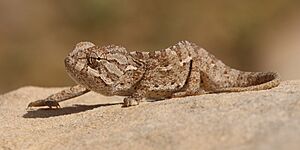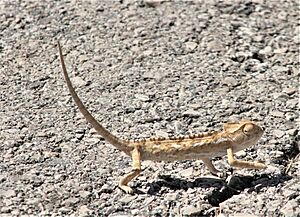Common chameleon facts for kids
The common chameleon or Mediterranean chameleon (Chamaeleo chamaeleon) is a fascinating type of chameleon found in the areas around the Mediterranean Sea and parts of the Red Sea. It's special because it's the only chameleon species that naturally lives in Europe.
Quick facts for kids Common chameleon |
|
|---|---|
 |
|
| C. c. recticrista Dana Biosphere Reserve, Jordan |
|
| Conservation status | |
| Scientific classification | |
| Genus: |
Chamaeleo
|
| Species: |
chamaeleon
|
Contents
Common Chameleon Subspecies
Did you know there are different kinds of common chameleons? These are called subspecies. Scientists currently recognize four main subspecies:
- C. c. chamaeleon (Linnaeus, 1758) – This is the main type.
- C. c. musae (Steindacher, 1900)
- C. c. orientalis (Parker 1938)
- C. c. rectricrista (Boettger, 1880)
What Does a Common Chameleon Look Like?
Common chameleons are usually about 20 to 40 centimeters (8 to 16 inches) long. Female chameleons are often bigger than males. Their color can change a lot! They can be yellow, brown, green, or even dark brown. No matter their main color, they always have two light lines along their sides. They also have a small "beard" of scales and some hard scales on their back.
Why Do Chameleons Change Color?
Many people think chameleons change color just to hide. But it's more than that! They change color because of the light and temperature around them. Their colors also show how they are feeling, like a chameleon's body language. For example, they might turn a dark color if they are stressed. Their colors are also important for talking to other chameleons, especially when they are looking for a mate.
How Common Chameleons Live

Common chameleons love living in trees and bushes. They are very good at climbing! Their feet have five toes, grouped into two or three on each side. This helps them grip branches tightly. They also use their tail to help them balance and stay steady.
Chameleon Movement and Behavior
These chameleons usually move slowly. They often sway a little bit, which helps them blend in and avoid being seen by animals that might want to eat them. But if they are fighting over their territory, they can move much faster!
What Do Common Chameleons Eat?
Common chameleons are insectivores, which means they eat insects. They catch their food in a super cool way! They sneak up on an insect, then shoot out their long tongue very quickly. The end of their tongue is sticky and grabs onto the prey. They eat things like flies, bees and wasps, true bugs, crickets, grasshoppers, and beetles. Sometimes, adult chameleons have even been seen eating fruit.
How Common Chameleons Reproduce
Common chameleons usually live alone. They only spend time with other chameleons during the mating season. They can start having babies when they are about one year old. Females lay one group of eggs each year. Bigger females tend to lay more eggs, and males will sometimes fight over them. The mating season is usually from mid-July to mid-September.
When it's time to mate, chameleons come down from the trees or bushes to find a partner. The female lays her eggs in the soil. The eggs then take a long time to hatch, usually about 10 to 12 months!
Where Do Common Chameleons Live?
In Europe, you can find common chameleons naturally in southern Portugal, southern Spain, southern Italy, Cyprus, and the Greek island of Crete. They have also been successfully brought to other Greek islands, the Canary islands, and Malta. In Malta, it's thought that priests brought them around 1880. Since then, they have spread across the island and even to Gozo, Malta's sister island. There are also small groups in southern Italy, in places like Apulia and Calabria.
In North Africa and the Middle East, common chameleons live in many countries. These include Morocco, Algeria, Tunisia, Libya, Egypt, Israel, Palestine, Jordan, Western Sahara, Saudi Arabia, Yemen, Turkey, Lebanon, Syria, Iraq, and Iran. In Greece, they are now mostly found on the island of Samos. Groups like the Archipelagos Institute of Marine Conservation are working hard to protect them there.
Protecting Common Chameleons
Even though common chameleons are found in many places, they face some dangers. Their homes are sometimes lost because of new buildings or farms. They can also be hunted by pets, illegally collected for the pet trade, or hit by cars on roads. Wildfires are also a big threat in places like Turkey. Protecting their habitats is important to make sure these amazing creatures continue to thrive!




